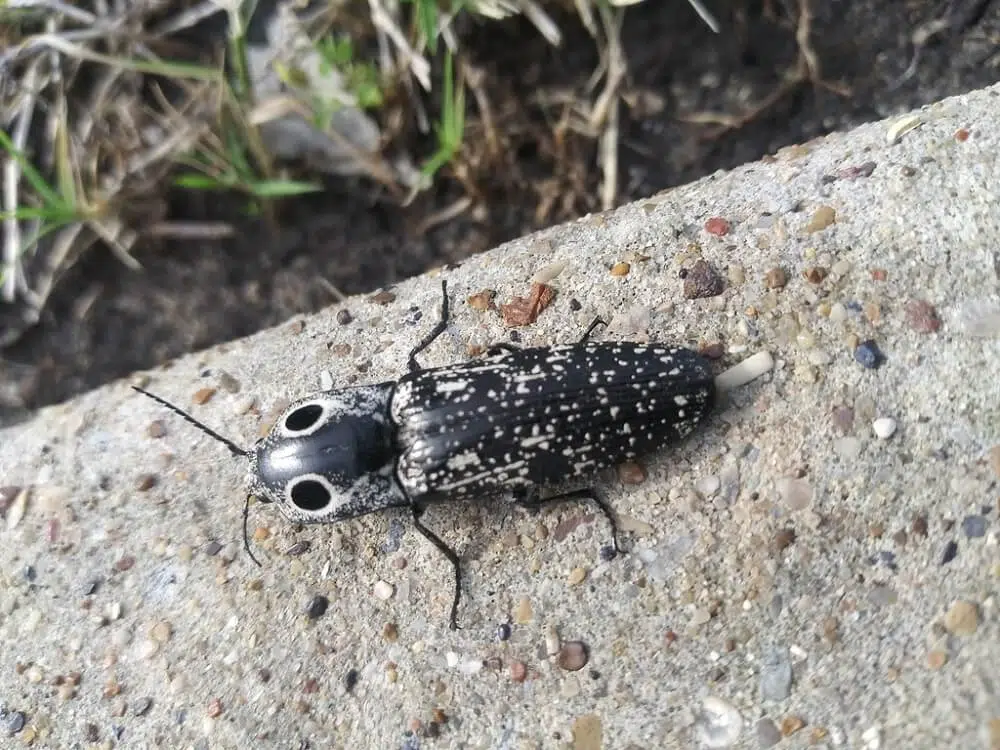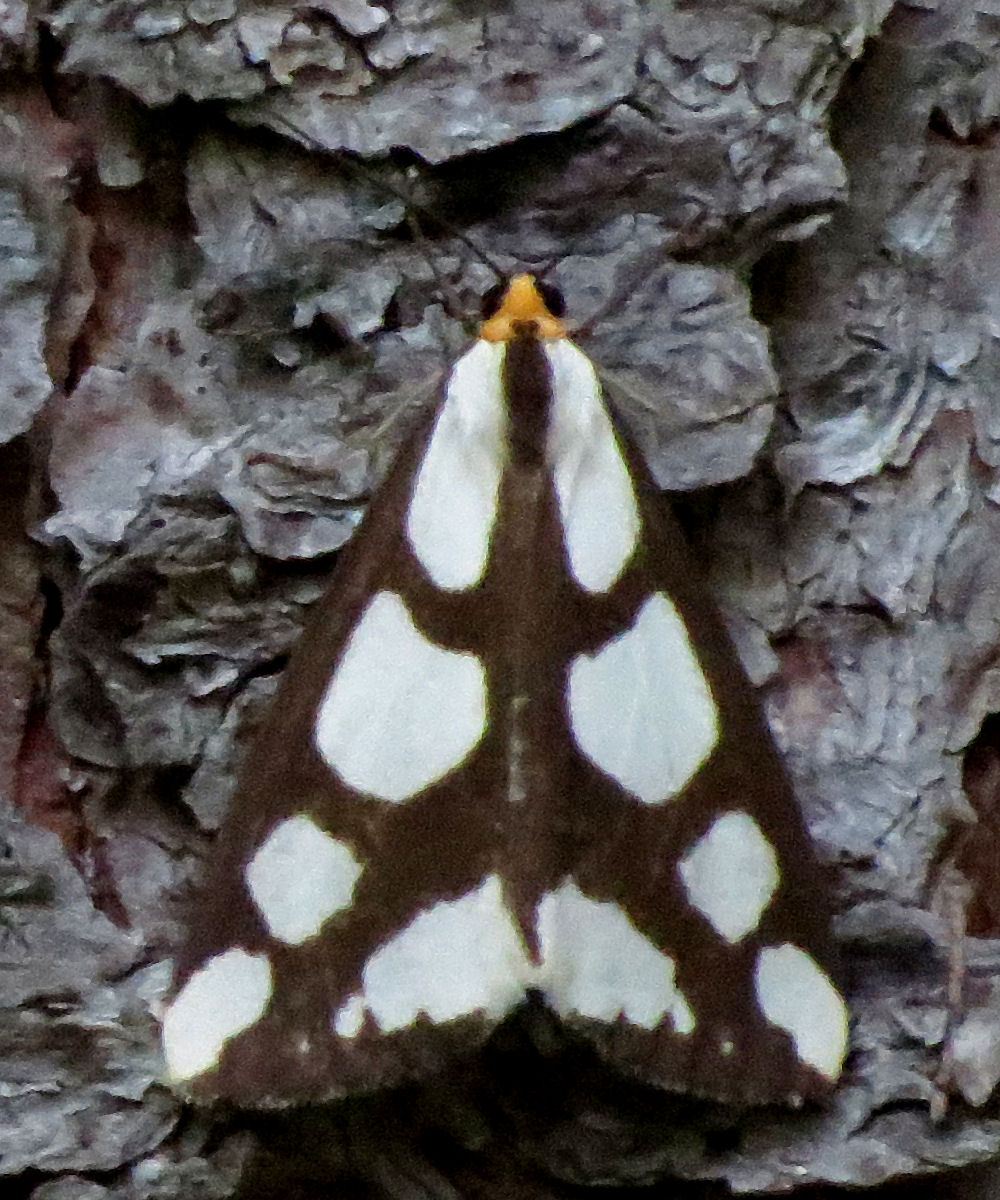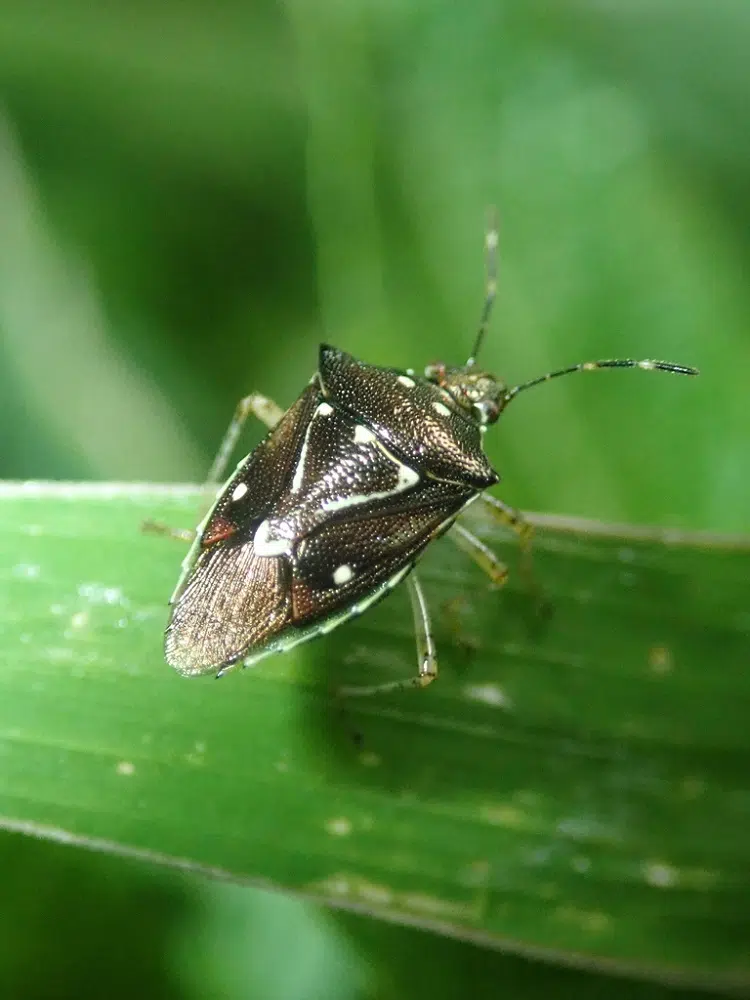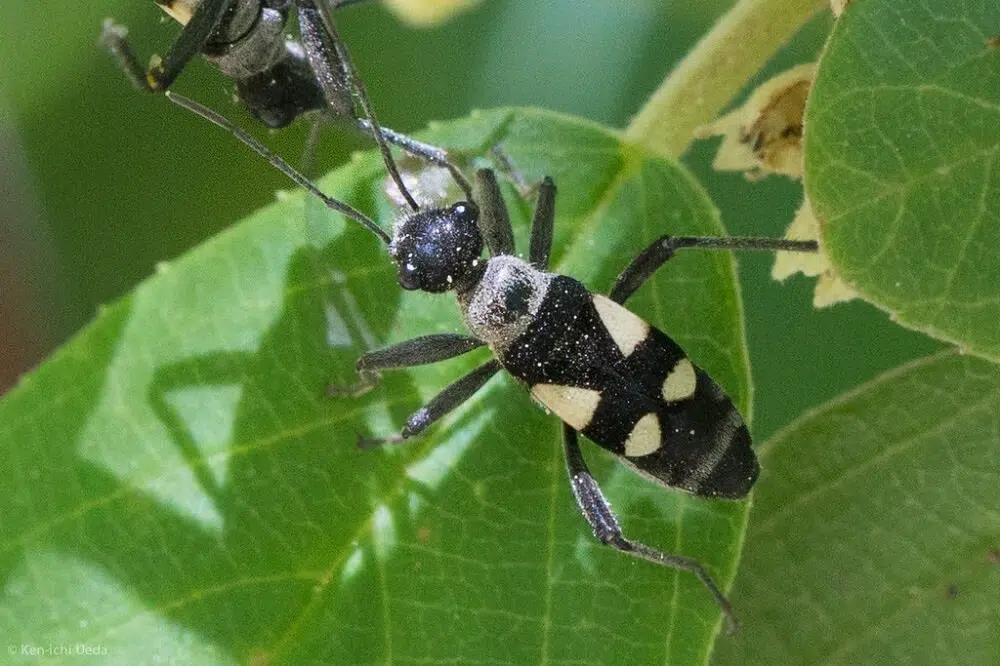Have you recently seen a black bug with white spots in your home, garden, or when you were out and about? Are you wondering what the bug is and whether you need to be concerned?
We have put together a list of the most common black bugs with white spots, helping you identify what you saw.
Table of Contents
1. Spotted Lanternfly
The Spotted Lanternfly (Lycorma delicatula) is indigenous to part of China, though it has become invasive in South Korea, Japan, and the United States.
Its host plants include stone fruits and grapes and it prefers the Chinese tree of heaven (Ailanthus altissima). When in its natural habitat, the population is controlled by parasitic wasps.

In their early stages, they are black and white nymphs, developing red on their wings as they age. As adults, they have black heads with gray wings and the back wings are red. As adults, they are known to cause serious damage to ornamental plants and crops.
They were accidentally introduced to South Korea in 2006, later in Japan in 2009, and have been recorded in the United States since 2020, where they have become an invasive species in most of the Northeastern United States.
They grow to 25mm in length and 12mm in width as adults. The red hind wings are not always visible when they are resting, though you will see some red as they are visible through the fore wings.
2. Eastern Eyed Click Beetle

The Eastern-eyed Click Beetle (Alaus oculatus) can grow to 45mm in length with an elongated body. They are black with a large oval patch of dark scales, which are framed in white. They can catapult themselves away from danger. They do this by releasing energy, which is stored in the click mechanism.
As adults, they do not eat much, with a diet consisting of plant juice and nectar. As larvae, they feed on grubs of wood boring beetles. The larvae, are voracious and can eat more than two hundred wood-boring beetles each.
They are found throughout North America and Central America, where they prefer forests and woodlands.
3. Texas Eyed Click Beetle

The Texas Eyed Beetle (Alaus lusciosus) is elongated with a shield behind the head. They are flattened in shape and can range in size. They are black and can grow to two inches in length. They have oval eye spots on the pronotum and gray wings.
When turned on their backs, they click. This means they snap their thoracic segments, causing their bodies to flip into the air and helping them right themselves. As larvae, they are known as wireworms with hard bodies and grow in color.
Most are relatively dull in color. They use their click to startle possible prey and help them evade an attack. They are nocturnal, hiding during the day. They are attracted to artificial light, which is why you may find one in your home. They feed on nectar and are not harmful to humans.
4. Ocellated Tiger Beetle

The adult Ocellated Tiger Beetle (Cicindela ocellata) can grow to half an inch and is easily recognized by its long legs and antennae. They are different from ground beetles, as they have heads that are wider than the thorax.
These beetles are black or gray-brown with white spots and markings on their wing covers. Sometimes they may show some metallic coloration, including bronze, green, and blue. Adults have hairs on the head and face.
This beetle spends its winter in deep burrows in the soil and eggs are laid in single burrows. The larvae dig burrows in the soil as they grow. These burrows can be more than one foot deep, usually seen in hard-packed sand.
The Ocellated Tiger Beetle is common on sunny days, especially in sandy areas. They are common along river and stream banks. They will run or fly away when approached. Note, that they will bite if you handle them roughly.
5. Tumbling Ragdoll

The Tumbling Ragdoll (Mordella marginata), also known as the tumbling flower beetle, comprising of one thousand five hundred beetle species. They are known for jumping, tumbling, and turning when caught or disturbed.
These are black and can grow to 7mm in length. They are commonly seen on flowers. They are humpbacked and wedge-shaped, usually covered in fine hairs. There is tapering at the end of the abdomen.
6. Banded Alder Borer

The Banded Alder Borer (Rosalia funebris) is a dark beetle with three white bands. The thorax is white with a large black spot. They have banded black and white antennae. The male has antennae that are longer than its body, while the females have shorter antennae. They have narrow and long bodies, growing up to 38mm in length.
You are likely to encounter the banded alder borer in western North America, California, and Alaska. They have also been seen in New Mexico and Washington, usually in the spring to summer. They are commonly found on the bark of alder trees.
If you have recently painted your house, then chances are you will spot these beetles that seem to be drawn to recently painted buildings, resting on the paint. As adults, they feed on flowers, while larvae feed on wood.
They will make an audible noise if you threaten or handle them. They give off a hiss, which sounds like the air being let out of a tube, or a squeaking running shoe.
7. Hairy Rove Beetle

The Hairy Rove Beetle (Creophilus maxillosus) is shiny and black, growing to 18mm in length. They have large eyes with their mandibles closing across each other. If handled, they can inflict a painful bite. The antenna is beaded and thick, comprising of eleven segments.
They lay milky white eggs, which take around four days to develop. The larvae stage is fourteen days and the pupae stage is sixteen days. They are commonly encountered in the woods, from spring through to autumn. They are very active and will run or fly swiftly with their abdomen tip raised like the stinger of a scorpion.
They are commonly seen in the eastern United States in wooded habitats. They are predators are larvae and adults with curved mandibles used for chewing. They feed on carcasses and maggots that they find on dead animals.
8. Eight-spotted Flea Beetle

The Eight-spotted Flea Beetle (Omophoita cyanipennis) belongs to the Chrysomelidae family and is common in the Caribbean Sea, Central, and North America. They have black elytra and eight black spots. The thorax is orange with a black and white head.
They are found in a variety of sub-suburban habitats, around plants and trees. They are called flea beetles as they use their legs to jump away from predators.
9. Leconte’s Haploa Moth

When resting the Leconte’s Haploa Moth (Haploa lecontei) looks like a triangle. It has black and white wings that lay flat on the body, touching each other. There is a thick black midline that is halfway down the moth’s length.
The fore wings have black borders, while some may have black angled lines from the outer edge. Others are black with white spots. Females lay yellow eggs on the host plant leaves. The caterpillars are black with yellow down their sides and back. They feed on a range of tree and shrub leaves. They can grow to 50mm in size as adults.
10. Buck Moth

You will often encounter the Buck Moth (Hemileuca maia) in oak forests in most of the United States. They were first described in 1773. As larvae they are covered in spines, attached to a poison sac which can cause stinging, itching, burning, and nausea. They are listed as endangered in Connecticut.
As larvae, they feed on oaks, including white oak, scrub oak, and live oak. In Louisiana where live oaks are used as street trees, these caterpillars can become a nuisance.
11. Polka-Dot Wasp Moth

The Polka-Dot Wasp Moth (Syntomeida epilais) is native to the Caribbean. As larvae, they feed on the oleander plant and fly during the day. They can be found in North America, commonly seen in Florida and South Carolina, and sometimes in Texas and Mississippi.
They are metallic blue with white polka dots on the wings and upper abdomen. The abdomen tip is bright red. This makes them mimic a dangerous wasp, but they are completely harmless.
As caterpillars, they are orange with dark hairs but do not inflict pain. As larvae, they have a gluttonous appetite, found in the oleander plant. They can cause severe damage to the plant. They are also known to feed on devil’s potato plants and desert rose plants.
12. Grape Leaffolder Moth

The Grape Leaffolder Moth (Desmia funeralis) belongs to the Crambidae family and is commonly seen in the southern parts of the United States and California. They are also encountered in the northeastern States and southeastern Canada.
They can grow to 28mm in wingspan and fly from May to September. They fly during the day and are considered minor pests to grapes in the United States. They have a white patch on the underside of the abdomen. Females have a pitched spot on their hind wings.
13. Peppered Jumping Spider

The Peppered Jumping Spider (Pelegrina galathea) is endemic to North America and can be found in grassy areas with an abundance of sunshine. They are black with white spots or look more mottled gray.
As with other jumping spiders can jump significant distances for their size, which they use to evade predators and prey on insects for food. They are not dangerous, though they can inflict a painful bite if threatened.
14. Garden Fleahopper

The Garden Fleahopper (Microtechnites bractatus) is a plant bug, native to the eastern United States and Canada. They are common garden pests and are often encountered in the warmer months. They complete their life cycle within thirty days.
Adults are shiny black with yellow on the legs and antennae. Males are thin and can grow to 2.1mm in length, females are stockier and grow to 2.2mm in length. They hop when disturbed.
They prefer leguminous crops such as beet, cabbage, cucumber, and eggplant. They also feed on potato, pumpkin, squash, tomato, and sweet potato. They are known to cause damage to clover, sweet clover, and alfalfa crops.
As adults and nymphs, they feed on the plant leaves and stems, where they suck the sap from the cells, which causes the plant’s death. It shows up as yellow or white speckles on the foliage.
15. Mormidea v-luteum

This plant bug was first described in 1796 and there have been hundreds of observations, especially in rice and ryegrass crops. They cause significant damage which slows the growth of the crops, reducing productivity.
The Mormidea v-luteum is black with white spots and brown on the legs and underside of the body. They have a hard body. They are considered a serious threat to rice and ryegrass crops.
16. Arhaphe arguta

This plant bug belongs to the Largidae family with twenty-six described species, one being the Arhaphe arguta. They are small bugs that make a noise when rubbing their fore wings against their coastal margin.
They are commonly found throughout the United States, including southern and central America.
17. White-spotted Fruit Chafer

The White-spotted Fruit Chafer (Mausoleums amabilis) is found in most habitats in Southern Africa and is shiny black with white spots. They are often seen feeding on garden blooms in low numbers. They are attracted to sap flows and fruit baits; they are sometimes even seen in bird nests.
The larvae develop in horse and goat dung and look like C-shaped grubs.
18. Marbled White

The Marbled White (Melanargia galathea) is a butterfly, belonging to the Hymphalidae family. They are encountered throughout Europe and Southern Russia, along with Asia and Iran. They are often seen in forest edges and clearings, along with meadows. They expanded in the United Kingdom in the late twentieth century.
They have a wingspan of up to 56mm and are considered medium in size. They have decorated wings in black or dark brown with white. Underneath is light gray or brown. As caterpillars, they grow to 28mm in length and are green or yellow with dark longitudinal lines and a light brown head.
19. Six-spot Ground Beetle

The Six-spot Ground Beetle (Anthia sexguttata) can grow to 4cm in size and are black with six large white spots, four are found over the elytra and two on the thorax. As larvae, they are flat with a large head and prominent mandibles.
They are common in South Asia in dry areas, as well as in scrub forests in India. They feed on snails and other insects as adults.